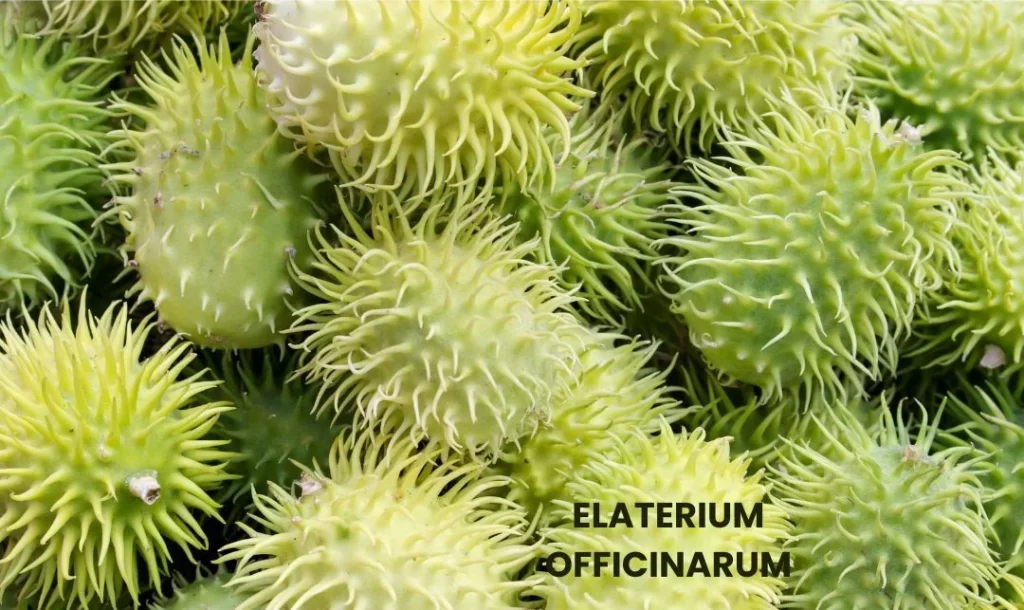Elaterium Officinarum, commonly known as Squirting Cucumber, is a powerful homeopathic remedy particularly useful for addressing severe vomiting and diarrhea.
It is also effective in treating certain types of dropsy (Oedema), beriberi, choleraic conditions, urticaria, and mental disorders that arise due to suppressed malaria.

SOURCE INFORMATION
Scientific Classification
- Kingdom: Plantae
- Order: Cucurbitales
- Family: Cucurbitaceae
- Genus: Ecballium
- Species: Ecballium elaterium
Common Names
- Squirting Cucumber
- Exploding Cucumber
Origin
- Elaterium Officinarum, commonly known as Squirting Cucumber, is native to the Mediterranean region, including parts of Europe, North Africa, and Western Asia.
- This plant thrives in warm, temperate climates and is often found in rocky and dry soils, as well as in coastal areas.
Historical Facts
- Ancient Uses: The use of the Squirting Cucumber dates back to ancient Greece and Rome.
- It was documented by early physicians like Dioscorides and Pliny the Elder for its potent cathartic (laxative) properties.
- Medical History: In the 18th and 19th centuries, the extract from the fruit of the Squirting Cucumber, known as Elaterium, was widely used in Western medicine as a powerful purgative.
- It was recognized for its ability to induce intense evacuation of the bowels, making it useful in treating dropsy (Oedema) and other conditions requiring strong cathartic action.
- Homeopathic Introduction: Elaterium Officinarum was introduced into homeopathic medicine based on the principle of “like cures like.”
- Homeopaths utilized its effects in extremely diluted forms to treat similar symptoms of violent purging and severe diarrhea.
Botanical Description
- Plant Type: Ecballium elaterium is a perennial herbaceous plant.
- Stem: The stems are trailing or creeping and can grow up to 1 meter in length.
- Leaves: The leaves are rough, heart-shaped to triangular, and covered with coarse hairs.
- Flowers: The plant produces yellow, bell-shaped flowers that are unisexual, with male and female flowers on the same plant (monoecious).
- Fruits: The fruit is an elongated, oval-shaped gourd-like structure that contains seeds. When ripe, it explosively ejects its seeds, hence the name “Squirting Cucumber.”
Chemical Composition
- Elaterin: The active compound in Elaterium Officinarum is elaterin, a potent hydragogue cathartic.
- Elaterin is extracted from the juice of the fruit and is responsible for its strong purgative effects.
- Other Constituents: The plant also contains various alkaloids, saponins, and cucurbitacins, contributing to its medicinal properties.
Preparation in Homeopathy
- Homeopathic Potency: In homeopathy, Elaterium Officinarum is prepared by triturating the dried juice of the fruit with lactose.
- This preparation is then further potentized through serial dilution and succussion to create homeopathic remedies in various potencies.
DRUG PATHOGENESIS
- Elaterium works primarily on the gastrointestinal system, inducing violent vomiting and purging.
- It also affects the skin, respiratory system, and extremities.
- It is particularly noted for its action in conditions caused by damp weather and suppressed malaria.
KEY CHARACTERISTICS
STOMACH
- Severe nausea and vomiting accompanied by significant weakness.
- Griping pains in the bowels.
STOOL
- Watery, copious, and forceful diarrhea.
- Squirting diarrhea that is frothy and olive green, with cutting abdominal pain.
EXTREMITIES
- Sharp pains in fingers, thumbs, knees, toes, and instep.
- Gouty pain in the great toes.
- Pain extending down the extremities, especially in the hip joints, often accompanied by diarrhea.
- Presence of arthritic nodules.
SKIN
- Sensation of smarting, stinging, and burning.
- Dropsical (Oedematous) conditions.
- Urticaria arising from suppressed intermittent fevers.
- Skin may take on an orange colour.
FEVER
- Chills accompanied by much yawning and stretching.
- Pain in extremities, particularly darting into fingers and toes.
- Chills and fever associated with spurting diarrhea.
MODALITIES
- Worse: Exposure to damp ground.
RELATIONSHIP WITH OTHER DRUGS
- Compare with: Bryonia (Bry), Croton Tiglium (Croton), Gambogia.
DOSE
- Homeopathic Potency: Third to thirtieth potency.
- Hydragogue Cathartic Use: To produce free discharge in dropsies, Elaterin in 1/20th of a grain is used palliatively.
Frequently Asked Questions
What conditions can Elaterium Officinarum treat?
- It is primarily used for severe vomiting and diarrhea, certain forms of dropsy, beriberi, choleraic conditions, urticaria, and mental disorders due to suppressed malaria.
How should Elaterium Officinarum be taken?
- It can be taken in potencies ranging from the third to the thirtieth.
- For specific conditions like dropsies, a hydragogue cathartic dose of Elaterin (1/20th of a grain) may be used palliatively.
What are the primary symptoms indicating the need for Elaterium Officinarum?
- Symptoms include severe vomiting, forceful and watery diarrhea, gripping abdominal pains, sharp pains in extremities, skin conditions like urticaria, and chills with yawning and stretching.
What are the common modalities associated with Elaterium Officinarum?
- Symptoms worsen with exposure to damp ground.
Meaning of Difficult Words
- Dropsy: Edema or swelling due to fluid retention.
- Beriberi: A disease caused by a deficiency of thiamine (vitamin B1).
- Choleraic: Resembling or relating to cholera.
- Urticaria: A skin condition characterized by hives or welts.
- Griping: Sharp, spasmodic pains.
- Arthritic nodules: Small lumps or bumps that form over joints in rheumatoid arthritis.
- Hydragogue cathartic: A type of strong laxative that increases the secretion of watery fluids in the intestines.
This comprehensive overview provides a detailed understanding of Elaterium Officinarum, its uses, and characteristics in homeopathic medicine.
